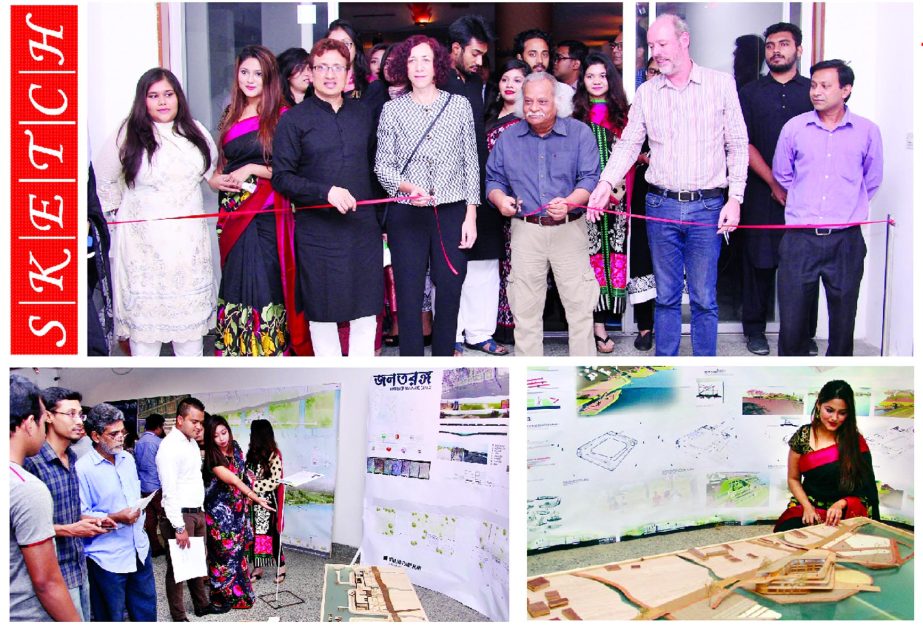
Sheikh Arif Bulbon :
The architectural exhibition of Department of Architecture, BRAC University titled River Rhapsody: Museum of Rivers and Canals was held at La Galerie of the Alliance Française de Dhaka (AFD) in the city’s Dhanmondi area. The inaugural ceremony of the week-long exhibition was held
on September 16.
Eminent architect Prof Shamsul Wares graced the occasion as chief guest, while Alejandra López García, chargé d’affaires, the Embassy of Spain
in Dhaka attended the event as special guests and architect and
architectural historian Dr Adnan Morshed also present as the guest of honour on the occasion.
Rivers are epic stories, engraved in geography. Nowhere is this phenomenon more poignantly demonstrated than in the Bengal delta. Contemplating Bengal’s aquatic cartography,
Poet Jibananando Das wrote: “…The River murmurs something on its way through.” In his soliloquy with the river, Jibananando, like many others,
discovered the nature of Bengal, a riverine tapestry that weaves together humanity with an archetypal consciousness of nature. Rivers are Bengal’s
lifeline. They make Bengal Bengal. Yet, in the name of progress, in the last three decades or so rivers and canals
in urban Bangladesh have been encroached upon to create land for growth and gentrification. They have been seen as dumping ground for industrial wastes. The pollution of river waters has shown the dark side of
prosperity. The melancholy of disappearing rivers and canals can now be felt across Bangladesh.
In this context, third year architecture students of the Department of Architecture at BRAC University faced the challenge of building public awareness through the design of a Museum of Rivers and Canals along the Karnafuli River in old town Chittagong. In
addition to showcasing the history, geography, and economy of rivers and canals through a host of exhibits at the museum, the architecture of the
museum itself was envisioned as a solemn reminder of our responsibility toward Bengal’s precious ‘waterscape.’ Guided by Prof Adnan Morshed and Abul Fazal Mahmudun Nobi, six
student groups responded to this design challenge by combining research, aesthetics, and a deep sense of
environmental ethics. n
The architectural exhibition of Department of Architecture, BRAC University titled River Rhapsody: Museum of Rivers and Canals was held at La Galerie of the Alliance Française de Dhaka (AFD) in the city’s Dhanmondi area. The inaugural ceremony of the week-long exhibition was held
on September 16.
Eminent architect Prof Shamsul Wares graced the occasion as chief guest, while Alejandra López García, chargé d’affaires, the Embassy of Spain
in Dhaka attended the event as special guests and architect and
architectural historian Dr Adnan Morshed also present as the guest of honour on the occasion.
Rivers are epic stories, engraved in geography. Nowhere is this phenomenon more poignantly demonstrated than in the Bengal delta. Contemplating Bengal’s aquatic cartography,
Poet Jibananando Das wrote: “…The River murmurs something on its way through.” In his soliloquy with the river, Jibananando, like many others,
discovered the nature of Bengal, a riverine tapestry that weaves together humanity with an archetypal consciousness of nature. Rivers are Bengal’s
lifeline. They make Bengal Bengal. Yet, in the name of progress, in the last three decades or so rivers and canals
in urban Bangladesh have been encroached upon to create land for growth and gentrification. They have been seen as dumping ground for industrial wastes. The pollution of river waters has shown the dark side of
prosperity. The melancholy of disappearing rivers and canals can now be felt across Bangladesh.
In this context, third year architecture students of the Department of Architecture at BRAC University faced the challenge of building public awareness through the design of a Museum of Rivers and Canals along the Karnafuli River in old town Chittagong. In
addition to showcasing the history, geography, and economy of rivers and canals through a host of exhibits at the museum, the architecture of the
museum itself was envisioned as a solemn reminder of our responsibility toward Bengal’s precious ‘waterscape.’ Guided by Prof Adnan Morshed and Abul Fazal Mahmudun Nobi, six
student groups responded to this design challenge by combining research, aesthetics, and a deep sense of
environmental ethics. n

